New exercise classes for Tulalip tribal members and patients of the health clinic
syəcəb
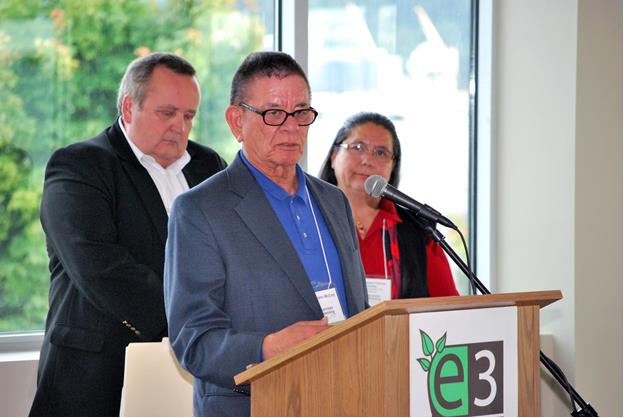
By Andrew Gobin, Tulalip News
Senator John McCoy received the Diversity in Action-Individual E3 Washington Green Apple Award on June 26 for his work in environmental education. He has in mind education for the environment to be incorporated throughout all levels of learning, including post-secondary education programs. While protecting the environment is mutually beneficial, it is often a sensitive subject with specific community concerns attached. McCoy, a member of the Tulalip Tribes, is diligent in making sure that each diverse community is represented in every issue, working to set attainable goals for sustainability on that everyone can agree on.
Steve Robinson, an Olympia based businessman who nominated McCoy, said, “Senator McCoy has been a tireless leader in many capacities which have served environmental education, multiculturalism and diversity well. His presence on ‘the hill’ in Olympia has provided an immeasurable amount of benefit to both tribal and non-tribal people and governments. He has sponsored phenomenal, far-reaching legislation, ranging from bills to integrate Indian culture and history into the classroom to a bill to establish Indian Heritage Day. Senator McCoy is one of the hardest working legislators in Olympia and he is committed to the protection and restoration of a healthy, vibrant environment for all.”
In addition to advocating for culturally sensitive environmental education, McCoy is tenacious and steadfast in his opposition of bills that would be potentially harmful to the environment, working to block them as much as possible.
“Last year, I successfully blocked legislation that would have allowed for water to be repurposed without regulation. This prevented water allocated for personal or agricultural purposes from being repurposed and used commercially, which would have created a loophole in current regulations,” said McCoy.
The work McCoy does to contribute to education for the environment, in addition to the work to prevent detrimental legislation, represent the magnitude of his career. According to the E3 statement, the Washington Green Apple award for Diversity in Action, “recognizes an individual, organization, tribe or program that demonstrates cultural awareness and encourages a multicultural approach to environmental and sustainability education programs while exemplifying the Lead Green goal.”
McCoy said, “I am honored to receive this award, and thankful for the recognition of the magnitude of work I have been involved with.”
While recognized for his work in environmental education, McCoy’s career has centered on water issues. He is also a strong proponent in Washington of legislation promoting the research and use of alternative energy, working to pass i937 last year, which deals with the state’s Renewable Energy Portfolio and standards on greenhouse gasses.
Andrew Gobin is a staff reporter with the Tulalip News See-Yaht-Sub, a publication of the Tulalip Tribes Communications Department.
Email: agobin@tulalipnews.com
Phone: (360) 716.4188
By Kyle Taylor Lucas, Guest Writer, Tulalip News
This is the final installment in a series exploring the largest demographic of American Indians and Alaska Natives–the Urban Indian. Through in-depth interviews, the series touches on some of the struggles, hopes, and aspirations of a largely invisible population.
The series introduction, Urban Relatives: Where do Our Relations Begin and End? provided a snapshot of urban Indian demographics and an overview of historical federal policies, which, according to the 2010 census, finds an astounding 78 percent of all American Indians/Alaska Natives residing off-reservation or outside of Native communities.
The second installment, The Tahoma Indian Center: Restoring and Sustaining the Dignity of Urban Indians, looked at a heroic urban Indian program that daily saves lives while operating on a shoestring. It recognized the Tahoma Indian Center and its director of more than 22 years, Joan Staples Baum. The story featured Tyrone Patkoski, an enrolled Tulalip member, known in the art world for his unique artistry.
Third in the series was “Tulalip Veteran Wesley J. Charles, Jr., True American: “Indian Born on the 4th of July.” It told the remarkable story of Tulalip elder and Viet Nam Veteran, Wesley J. Charles, Jr., and a life well lived.
The fourth story, Why Should Tulalip Tribal Members Care About the Affordable Care Act? focused upon the Affordable Care Act’s (ACA) benefits to tribal members, especially low-income urban Indians–the majority of whom have long barely survived without any health and dental care, whatsoever, and who stand to benefit most from the ACA.
More than 1 million American Indians and Alaska Natives, approximately two-thirds of the U.S. Indian population, now live away from their reservation or homelands. Their displacement is traceable to broken treaty promises, the Indian boarding school legacy, federal assimilation policies, forced relocation, termination, widespread non-Indian adoption policies, overall failed federal trust responsibilities of the past century, and inter-tribal competition for a piece of the pie.
In particular, federal “Relocation” policies of the 1950s and 1960s resulted in Indians leaving the reservation in droves. As part of its “Termination” and “Assimilation” policy, the Bureau of Indian Affairs (BIA) offered grants and job training to entice Indians to leave for employment in urban areas. The promise of food on the table and a roof over the heads of one’s family appealed to hungry, impoverished, and un-housed Indians. Survival can be very seductive.
The intent of these federal policies was to remove Indians from the reservation in order to end federal trust responsibility. Unquestionably, the Diaspora’s cruel result is generations of Indians split from their sacred lands, people, culture, language, and traditions.
A largely untold story is that urban Indians were then and continue to be subject to devastating economic and social strife. For the most part, this invisible population receives a blind eye and a deaf ear from the federal government charged with its trust responsibility. In their opposition to urban Indian program funding, even tribal governments aid the injustice. As example, despite the fact that 78 percent of all American Indians/Alaska Natives reside off-reservation, only 1 percent of the federal Indian Health Service (IHS) budget is allocated to urban Indian health care. This did not happen by accident.
Moreover, despite a highly technological age, data to document the urban Indian condition is woefully lacking. Still relevant today are findings from a 1976 American Indian Policy Review Commission study. It found, “Government policies meant to assimilate if not eliminate, a portion of an entire race of people have created a large class of dissatisfied and disenfranchised people who, while being subject to the ills of urban America, have also been consistently denied services and equal protection guaranteed under the Constitution as well as by their rights as members of Federal Indian tribes.”
Regrettably, tribal government systems have also contributed to the struggle of their disenfranchised urban relatives. For example, at Tulalip, the Social Services Emergency Aid program, in place for countless years, disenfranchised its off-reservation tribal members by denial of access to emergency aid. When explanation was sought, none was forthcoming. Interview calls for this story were not returned. In essence, half of the Tulalip citizens were discriminated against. Already denied anything beyond basic health care at the tribal clinic, the added denial of emergency services was a bitter pill for many.
Tribal enrollment policies have also aligned to deny members identity. For example, the Tribes’ enrollment policy, based on residency rather than descendancy, has deprived generations of Indians rightful identity and affiliation with their people simply due to the accidental location of their birth and despite their descendancy and ancestor’s reservation allotments.
Even so, the urban Indian story is not all bleak. Many urban Indians strive to create and contribute to community with their urban Indian sisters and brothers, and to know their reservation families and communities. Some hope to return home one day when housing and employment opportunities align. Social media has also helped open avenues of communication and connection. Online tribal news outlets and opportunities for online language learning create new avenues of cultural affiliation and contribution. Add that the Affordable Care Act (ACA) is providing critical healthcare and dental services for urban Indians who have long gone without any care.
According to Rosalie “Rosie” Topaum of the Tulalip Tribes enrollment office, since December 2012, Tulalip enrollment numbers increased by 140 for a total enrollment of 4,422 with nearly half (2037) of all Tulalip citizens reside off the reservation. All but three of the new enrollments reside off reservation.
“Urban Indian” Stories

Jaime Denise Singleton
Born in Everett, Jaime Denise Singleton, 28, Tulalip, spent her first year on the Tulalip reservation. Her father, Dennis Boon, and her grandmother, Helen Gobin-Henson are Tulalip. Her mother, Pam (Marquis) Phipps, is Aleut. The family relocated to Anchorage, Alaska following her parents divorce when she was three years old.
Eager to know her roots, Singleton returned to Tulalip at age twenty-one. “I hardly knew my Dad and didn’t know my family at all. Grandma Helen helped me find work as a temporary youth advocate in the Education Department.”
Despite its enormous economic success, lack of housing continues to be a challenge for the Tulalip Tribes. Many of those on the reservation reside with large extended family in one house. Although not unlike historic tribal communal living, today’s housing structures and work and school lifestyles are largely incompatible.
The lack of reservation housing is also a significant driver for the continuing large urban Indian population. Singleton said, “I lived at my grandma’s house for about six months. I didn’t sign onto the housing list because I knew people with children who had been on the list for years and still didn’t have a house. At the same time, my grandma also had my uncle, his girlfriend and children, my dad, and two other cousins living with her. It was very crowded.”
A common regret of many urban Indians is the isolation from tribal culture and community. “I didn’t know my family or my culture. That’s the worst disadvantage. One of my cousins showed me her regalia from dancing as a child and I felt I really missed out on things like that. Some of my cousins are weavers and they make the most beautiful things from cedar. I thought, I know how to crochet, so I could have learned how to do that.”
Unfortunately, many urban Indians also experience isolation from other Natives. “Because I am mixed and light-skinned, I feel like an outsider in the Native community. I am only one-eighth Tulalip. On my mom’s side, I am Aleut, but only one-sixteenth. My maternal great-grandma married a white man and they moved out of her home village and homesteaded on the Kenai Peninsula. Our family has slowly drifted apart. I know nothing about our culture on the Aleut side either.”
Asked about healthcare, Singleton said, “Up here in Anchorage, AK, they have an excellent Indian Hospital called Alaska Native Medical Center that I believe sets the standard for Indian healthcare.” Yet, she recalled growing up visiting the clinic in Kenai where “I always got the sense it was free when I was young, but as an adult I’ve witnessed a hard push to buy health insurance. I feel like the staff and nurses look down on you if you are not insured.”
The Singletons objected to the necessity to sign up for the ACA or “Oamacare” as it is commonly known. “We filed the exemption because my husband was upset about the Individual Mandate. He didn’t understand why, as Native Americans with Treaty Rights, we should be forced to purchase insurance for the healthcare that is supposed to be provided us. He is one-quarter Inupiaq, but is not an enrolled tribal member and not qualified for the lifelong exemption; neither is our daughter.”
Economically, Singleton’s husband, Steven, has had steady employment. “We’ve been married for almost five years and we have property in Georgia where Steven was born and raised.” Having moved to Alaska after the Recession, they’re excited to be relocating to Georgia to build a house.
Grateful for the tribal per capita program, Singleton added, “Because we decided I would stay at home to raise our daughter, Sequoia, the per capita together with babysitting has really helped.” She is grateful, too, for the annual bonus, which has allowed them to “bank” for critical needs, such as their move to Georgia this summer.
On what Tulalip does right, Singleton said, “Our tribe values culture and respects traditions for ceremonies, gatherings, and funerals. It is wonderful to witness. I believe the Lushootseed language program should have greater emphasis because, like many native languages, it is on the verge of extinction. Our income from the Casinos puts us in a unique position to really “save” our language, and I would like to see that happen.”
To more equally serve the needs of off reservation members, Singleton suggested, “The tribe needs more housing! More than half of the homes in Housing Projects are left boarded up and abandoned while some of our membership lives with other family members, or homeless. I would like to see a program that opens up and turns the homes around faster and more homes available so our members have a place to live.”
“My family and extended family have always made me feel like I belong and that means a lot to me. They ask me things like, “When are you coming Home?” It makes me feel included because we know I was not raised there, yet it could still be my home,” said Singleton. She credited Facebook and social media for helping her to stay connected with her Tulalip family and community.
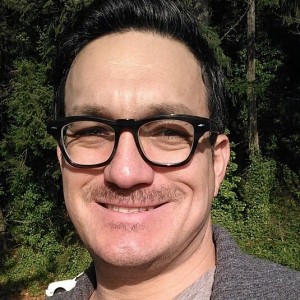
Myron Fryberg, Jr.
Myron Fryberg, Jr., 37, Tulalip, was adopted along with his sister, Joanne, by Myron Fryberg, Sr., and his wife, Mary. “I was adopted at the hospital. My mother is Tulalip and Puyallup, so I have ties with the Puyallup Tribe as well.” It was an open adoption allowing him to visit his birth mother, Deanne “Penny” Fryberg.
“My adopted mom, Mary, is full-blood and she knew all her relatives and family. I didn’t know myself. I was this kid who was given up by his dad. He was white,” said Fryberg who finally met his birth father’s family eight years ago. I learned that I’m Irish and Scottish, and a little French Canadian. The Irish are tribal too. The last name was O’Toole. I didn’t meet my dad, but I still talk to my brother.”
Residing off-reservation for the past five years, Fryberg said he was on the tribal housing waiting list, “but that’s a pretty slow process.” Caring for family at the time, he was forced to move “to town” [Marysville]. “I did a lot of praying and the idea came that maybe it was time to do something else. I was a janitor I asked, ‘do you want to turn 40 and realize that you didn’t do anything with your life?'”
Fryberg learned the Northwest Indian College (NWIC) offered a chemical dependency degree, so he returned to school. “I’ve now finished my third year and have a year to go,” said Fryberg, adding that he’s in the Tribal Governance and Business Management program.
Acknowledging that life has not been without challenges, Fryberg was candid about his struggles with alcohol. “I’ve been living in Bellingham for three years, going to school and staying busy. I had a rough patch at the beginning and I ended up getting a sponsor” who initiated him to service work. “We started working at the homeless shelter serving the homeless and I developed a sense of gratitude for what I had. Before that, I was hopeless about life,” said Fryberg who added, “I had lost my dad. I clung to him the most because I knew he was my relative. Me and my dad were really close. He always took me everywhere when I was a kid.”
Fryberg’s first tribal job was a blackjack dealer at age 19. “I did that for five years, but I didn’t like the structure there. I got clean and sober when I was 19, but I felt that I was treated less than by the tribe, so I went back to school and studied computers for three years.” Then, his friend committed suicide. “It put me back drinking for another four years. I finally quit drinking when I was 29.”
He again worked for Tulalip Tribes as a janitor at the health clinic and later at Tulalip Data Services. Yet, promises of raises were not forthcoming and Fryberg found the process for resolution of grievances unwieldy. He said that because he was supporting five children from family and a relationship, it was a turning point.
“When my dad passed I just didn’t want to be there. There was no chance for advancement or better pay and rather than go through the grievance process, I decided to return to school. I had seen the people that had an education made more money.”
Asked about disadvantages of living away from the reservation, Fryberg said, “There’s isolation. You get lonely. You don’t have your family, but Facebook has helped a lot.”
Unlike most urban Indians, healthcare has not been an issue for Fryberg. “We have non-profit health hospital in Bellingham. They don’t ask for paperwork.” He has also applied for Obamacare.
Fryberg said he is fortunate to live close to the reservation and a tribe with a similar culture. “The Lummi people at the college embraced me right away. I feel like they’ve kind of adopted me as one their own. It was good to see their culture is similar, but I always felt like Lummi was very close to their origins and held their culture close,” said Fryberg.
He noted having been immersed in his own culture at a young age. “We used to practice with the Jimicum family. We learned dance and songs and performed in Seattle. When my grandpa was ready to pass, my dad brought me to drum for him. My mom is Shaker, so we would go to shake on the weekends, and I helped in the kitchen,” said Fryberg. He has also studied Lushootseed.
Asked about his access to tribal social programs, Fryberg noted, “When I needed help, Tulalip said they couldn’t do because I was out of Snohomish County. There have been roadblocks there.”
He expressed gratitude for tribal per capita as having changed his life. “It has given me a chance to return to school and focus strictly on education.” He added, “The annual bonus has allowed me to put money aside to cover my rent when out of school over the summer.” It allows purchase of necessities he formerly had to forgo.
Fryberg conveyed some frustration with tribal government, “I think they are doing okay. Action seems to be a problem; presentation seems to be a problem. We try to cover up problems. We need to be more aware of where we came from. We need to change the whole philosophy. When we offer service to the people, we’re selling that service. Now, we’re offering a service that isn’t transparent. I tried to get the Board of Directors to hear my plea for non-profits, cooperatives, and getting people employed at Equal Square where there is no hierarchy. It’s a perfect example of assimilation. There’s a sense that oppression is all we know and that people don’t welcome change.”
Asked for specifics, he suggested pooling resources. “If $1,000 per capita is not enough [for people to survive], there’s a lot you can do if you pool your monies–franchising, manufacturing, businesses that have the ability to supply something. Voluntarily, as members, we could do this. If the tribe presented it to us as individual shareholders it would make it easier and if we had a business committee that knew how to invest. A $50 monthly cut in per capita could be invested by the tribe. It could create more revenue and jobs.”Regarding tribal policies, Fryberg expressed concern about structure. “I think there should be more emphasis on the other coat. In dealing with society, you have to wear two coats. One with your tribe and the other with the U.S. There isn’t enough emphasis on what they wear when they’re home. The policies have to change in terms of our leadership. Who are our leaders?” To illustrate his point, Fryberg pointed to the Onadaga in New York. “They “raise” leaders rather than choose based upon popularity. We’re left with the leadership that the federal government gave us–a Board of Directors.”
To better serve the needs of its off-reservation members, Fryberg wants the tribe to support cooperatives. “If more individuals were sharing, there’s the possibility of owning businesses and housing off the reservation. We could invest in, build, or occupy, as added income and owned property.” He emphasized the importance of water conservation and noted NWIC recycles their water. “We need to look at where we go from here, look at the environment, and go back to our customs. Solar would be good. We wouldn’t be supporting Keystone or pipelines. And it could create revenue for our tribe. It speaks to sustainability and supports our sense of identity, of who we are as a people.”

Jennifer Cordova-James
Born and raised on the Tulalip Indian Reservation, Jennifer Cordova-James, 22, is the daughter of Chris James and Abel Cordova. She is an enrolled Alaska Native of the Tlingit Indian Tribe. Her mother is Tlingit and her father is Quechua, of Peru. She has learned the traditional dishes, music, musical instruments, and regalia, but has not learned as much as she would like about her Peruvian people. Cordova-James said the same is true of her Tlingit people.
Cordova-James has resided off-reservation to attend Northwest Indian College (NWIC) the past nine months. She is pursuing a Bachelor’s Degree in Education and has moved back home to the reservation for the summer. She will graduate next winter and, afterwards, wants to return to Tulalip to work in administration or perhaps to do marketing for the casino.
Asked about paying for college, Cordova-James said, “Scholarships! My biggest funders are the American Indian College Fund, the Comcast Scholarship, and the Embry American Indian Women’s Leadership Project Scholarship.”
In terms of employment, Cordova-James spoke highly of the excellent work experience she gained in working at the tribal hotel.Her biggest challenges have been balancing her studies with extra-curricular activities. She has served on student executive board as vice-president of extended sites where she gathered concerns, suggestions, and ideas, at each of the NWIC sites to ensure that student voices were heard and resolved. She regards these as important learning experience while also being “fun years.”
Cordova-James said the greatest disadvantage of living away from the reservation has been “Trying to make a home away from home. I lived in the dorms and the biggest issue was missing home. I suppose a huge challenge for me were family issues or obligations. I would have to make hard choices about who to support. It was my second year moving out, but I come home for summer with family and community,” said Cordova-James.
She noted employment as a second disadvantage, “There were a lot of times that I filled out applications and finally decided to focus upon my studies. The work study positions filled up really fast.”
In terms of access to healthcare, Cordova-James said she had access to the Lummi clinic, but chose to visit the Tulalip health clinic on the weekends. The ACA helps in that she is on her parent’s health plan until age twenty-six.
Cordova-James enjoyed a great sense of community while attending NWIC. “Lummi welcomed me with open arms. The campuses are full of students from other Nations. Navajo, South Dakota, Lakota, Eskimo Inuit, Alaska, and from Canada.”
Enthusiastic and ambitious, Cordova-James has big ideas and plans. In March 2014, she was elected as Northwest Regional Representative to the American Indian Higher Education Consortium. They help tribal colleges and universities with foundation and grant funding, lobbying in Washington, D.C., and in Olympia.
“Also our big initiative is a culture exchange program within the tribal college. We want a program where tribal colleges and universities work together. Sometimes it feels like they’re working against each other. We want a program that includes common requirements. Right now, we’re brainstorming and tasking people to conduct research this year. It probably won’t be off the ground for a couple years, but it’s an initiative that we’re looking into–long term,” said Cordova-James.
Speaking to the crisis of drugs on the reservation, she said, “It’s heartbreaking, especially when you’re close with somebody and you went to school with that individual. It’s sad to see young tribal members dying. We need to support them, but not enable them. We need to educate the families.”
Cordova-James said it was interesting to get the question because she and her friend and classmate, Tisha Anderson-McLean, Tulalip, co-partnered on writing a grant proposal for their class final. She said, “We called it the “Quascud Traditional Housing,” which, in Lushootseed, means lightening the load or pulling forward in the canoe when someone’s having a hard time paddling. It was for traditional housing, directly for those members who are coming out of treatment to a journey of wellness.”
Quascud Traditional Housing would offer life skills classes, help with professional attire, interview and job hunting classes, and assistance applying to school and scholarships. “Sweat lodge, culture days, and bringing a traditional healing aspect to support the journey of wellness” would be emphasized, said Cordova-James. The facility is envisioned as an apartment to ensure privacy for those who want to be by themselves. Family visits are included, but it would be a closed facility with no overnight stays, and would include checkout passes in an earned program “We compared ours to Muckleshoot and one other,” said Cordova-James who acknowledged Myron James Fryberg for his support in brainstorming and advising on the proposal.
Cordova-James said, “We got a really good grade, we got an ‘A’ for that! We saw it had huge potential for carrying forward.” Although they have not yet done so, they plan to share it with the tribe. If she doesn’t have enough on her plate, Cordova-James is also a busy activist. “I like supporting the environment,” she said, adding that she worked on I-522–the Genetically Modified Organism (GMO) labeling initiative this past year. She also worked against the XL Pipeline and coal trains. “I was protesting. There’s one picture with ‘Idle No More’ on my face. Generally, I work against big corporations trying to kill small businesses and I’m interested in the international issues such as Australia versus Japan on the whaling issue.”
Anonymous Stories
In keeping with all of Indian Country, the effects of historical trauma are equally as devastating among urban Indian populations. It is reflected in the prevalence of social, mental, physical health, and substance abuse problems. Yet, the urban Indian population is treated as invisible with little funding devoted to services to improve the quality of their lives, indeed–their life chances.
Jan – Lakota Sioux
Some stories are so painful, so personal, that to protect their families the storytellers ask to remain anonymous. Using a pseudonym, Jan, 56, is Lakota Sioux from Standing Rock, South Dakota. Born and raised in Washington, she was in the first class of The Evergreen State College. An early activist, she recalled with some nostalgia the alliance of Native students who made and sold fry bread to help the American Indian Movement (AIM) at Wounded Knee. However, her activism began with the fish wars. “When I was in high school I became involved in environmental things, and then I became involved politically around AIM. It progressed from there. The way I’ve always looked at it, you don’t have to live on the reservation to know what is right or wrong. You don’t need to live there all your life,” said Jan.
At 19, Jan left college to live with her grandparents in South Dakota. “My grandma is Lakota and lived her whole life on the reservation. Though I visited them as a child, I wanted to connect with what I didn’t learn. I wanted to know my relatives and to experience first-hand what it was to live on the reservation,” said Jan. It was an exciting time during the early seventies and the beginnings of the American Indian Movement. “I went to the very first International Treaty Convention at Standing Rock,” said Jan.
She worked part-time for a cleaning business owned by tribal relatives on the reservation, then as a public school tutor’s aid, and doing odd jobs. In her free time, she went to Sundance.
Before long, she was married with a child, but her husband died in a mysterious swimming hole accident at Standing Rock. She moved back and forth between Washington and South Dakota and eventually worked on the film, “Thunderheart,” and her son was one of the village children in the film “Dances With Wolves”, playing with Dennis Banks’ children.” My son was healthy. He played soccer. He met Billy Mills. I have a picture with the two of them on the front page of a local paper. He even went on a 3-mile run with Billy Mills,” said Jan, proudly.
While living in South Dakota, she took her son to the tribal clinic. Yet, over the years, lack of access to IHS healthcare for him grew more difficult. She finally settled back in Washington and attended vocational school in 1992.
Jan’s life took a turn as her son grew into his mid-teens. He became unmanageable and she sent him to boarding school, where they determined he was an alcoholic. He went to treatment. Said Jan, “He was in jail for a whole year, and I wondered why he was acting like this. Something’s wrong here. And after he got out and had his daughter, then he got his diagnosis. Until then, I thought he didn’t have a dad, and his hormones are acting up, and he’s acting out. It started when he was around 15.”
He became violent and was eventually diagnosed with schizophrenia, in his late teens. That was complicated by his alcoholism, his involvement in gangs, and recurring arrests.
For most people, we have children, raise them, and then they go off to live their own lives. In Jan’s case, that has not, nor will it ever be the case. Since his late teens, her son has been jailed for Drunk in Public (DIP) more times than she can recall. On two occasions, he was jailed for a year at a time and other times too numerous to count–for months on end.
His dual diagnosis of alcoholism and mental illness makes treatment, which is often unsuccessful for any alcoholic, impossible for her son. Jan reports that upon his release from jail for DIP or domestic violence, he drinks within minutes. When he leaves treatment, he immediately drinks. “I tried to get my son into treatment through the Northwest Region in Portland, but they didn’t think he was a candidate. It was an alcohol and drug treatment program, but they didn’t have a mental health component. How can you have somebody in recovery that doesn’t have rational thought process?” Jan emphasized that alcohol treatment programs must have a mental health component. “They need to have a communal living situation, but they can’t come and go as they please. It almost has to be a lock down place. There has to be something there for them to do, nutrition, exercise, garden,” said Jan.
Jan said treatment and work release require getting to class and work, but her son doesn’t have the rational thought process to do that. She suspects his long-term alcohol abuse and maybe meth use as potential factors. “And it’s worse now because he now has black-outs. Dual diagnosis. Mentally Ill and Chemically Affected (MICA). They changed the name to co-occurring disorder. Then, they shut that program down due to lack of funding.”
Pointing to the ACLU, Jan said, “Oh mentally ill people do have rights. They have rights to be able to have a place to live. Yes, they have rights. How do we solve all of that if they can’t manage themselves? How is harm measured? You have to hurt somebody and kill somebody. My son has DIP charges all the time. He has a felony record, which is why he can’t get a place to live. Even when he does, all the others running around who are just like him make him lose it. He’s the Robinhood of the streets. I bought him a brand-new jacket and it’s gone.”
She can’t have him live with her. He loses, gives away to street people, or spends all his money on drinking; he often has no place to stay. Other times, he has been evicted yet again. He is on Social Security Disability. In the winter months, she gets him a hotel room. The rest of the time, “I had to take a hard breath and say “no” when he wanted to stay at my house. There were times I let him stay with me, but he goes through my stuff and has stolen from everyone in my family. He brings street people here. I just had to feel rotten and just do it. I had no other choice, “said Jan.
She found a support group that gave her hope, “Mothers of Adult Mentally Ill Sons.” Yet, as the meetings progressed, and the leader advised them “there is no hope,” and their numbers decreased with only four people in attendance at the end. “There was one lady that had two sons like my son and they were worse than him,” said Jan. “My son can go to treatment all he wants and that’s not going to help him. He can go to jail all the time, and it’s not going to help him. The only saving grace of him going to jail was his detoxing. But the day he gets out, he drinks. I’ve resigned myself that there is no hope under the current conditions, under anything they now have.”
“My hope is not of him recovering from his mental illness, but I hope for a secure place like a compound or communal place where he could be safe. There are places around the U.S., but they cost $20k to $30k a month. Basically, at the heart and core of his being is a pretty good person, but his illness gets in the way just like any alcoholic.”
Asked how she coped and took care of herself, Jan said at first it was by attending National Alliance on Mental Illness (NAMI) and co-occuring disorders meetings. “I started educating myself. That helps to a point, but like the other day when I took him to the dentist, when he got into the car, he had a psychotic episode. It just kills me inside and it hurts and I just want to die. Just get this pain away. Take this pain away. Because he’s in pain. I feel sad for my son because of the way he has to live. Any mother who has a son or daughter who has to live that way–it’s just painful and hurtful. I cope with it by talking to my friends, and talking to my brother, and talking to my partner who now understands. Boundaries is a big word. I’m tougher on my son than some mothers are. And I cry. You know it’s part of coping–if you can call it that. Crying is relief. Sometimes, you just cry. Also, just being involved in other things. I’ve been involved with my granddaughter, helping her as much as I can. Just being there for her. I’ve screamed and I’ve hollered when I’m driving down the road. I go to the YMCA,” said Jan.
Anonymous
Among other anonymous stories, there are the Indian women in their late fifties and early sixties living urban and alone, struggling month to month with few resources.
There is also the thirty-year-old Puyallup woman who spends her days at the Tahoma Indian Center and looks for a safe place to sleep at night. She has been unable to find work. Sometimes, she stays at the mission, but she worries about the bugs, so she often sleeps on the streets. She seems detached as she speaks about drinking. She “grew up with it.” It is surprising to learn that her mother who is only 53 is in a nursing home. Asked if illness caused her young mother’s placement in the home, the flat reply was, “No, she has wet-brain.” An inquiry about it was met with an incredulous reply, “You’ve never heard of wet-brain! My mother drank so much for her whole life, so it pickled her brain and she cannot take care of herself.”
Wet-brain is a real condition known as Wernicke-Korsakoff syndrome caused by long-term alcoholism. Its symptoms include mental disturbance; confusion; drowsiness; paralysis of eye movements; and staggering gait. It is primarily caused by a lack of thiamine (Vitamin B1) due to severe malnutrition and poor intestinal absorption of food and vitamins caused by alcohol. The wet-brain person acts much like the Alzheimer’s victim with loss of recent memory, disorientation to time and place, confusion, and confabulation (telling imagined and untrue experiences as truth). In its early stages, it can be prevented, but it cannot be undone.
Fifty-two year-old Jack is bright and well spoken. He is Canadian First Nation, but was born in Seattle in 1960. He hasn’t visited his home reserve in more than 30 years. Jack served four years in the Army, stateside. “I really enjoyed my military service. I learned a lot and regret not staying in. It had a lot of security,” said Jack.
Jack started visiting and found a home in the Tahoma Indian Center in the early 90s. As for now, he said, “I’m doing alright, staying alive.” After the service, he got labor work, mostly moving. Today, he does recycling.
Due to his parents’ drinking, he and his siblings were put into foster care early, two or three homes while he was very young. He was five when he was permanently placed into the system, “but I have blocked a lot of it out,” said Jack.
He admits to being an alcoholic, which sometimes prevents his access to the mission. Asked when he began drinking, Jack replied matter-of-factly, “Probably in the womb.” He said he never knew his mother not drunk.
In the next moment, Jack offered, “I learned a lot about natural foods and nutrition and quit drinking in the mid-80s to early 90s. I took up running and ran 26.2 miles in the Goodwill Games. We started at Gasworks Park. My time was 4 hours and 3 minutes. If I could come up with the equipment, I would probably resume running.” He confessed that he is “always dreaming. One of my goals, too, is to climb Mount Rainier.”
“For fun, I like to read–Dean Koontz, Stephen King, history, philosophy, political science, Indian–contemporary and history,” said Jack. He brightens even more in recalling a local doctor who for about seven years took the center rafting on the Deschutes in Oregon. He misses that.
Another Jack, Lakota, Sioux, spoke of how difficult it was to secure health care in Washington State. One local tribe turned him down, so he had to travel long distance to the Seattle Indian Health Center. He is now happily enrolled in an ACA plan.
Summary
Despite a sense of exclusion for some and of being “less than” experienced by others, most urban Indians continue to identify with their people, reservation communities, villages, and land. They share a common history and memories. Displaced from their reservations they seek community ties with other urban Indians. Yet they yearn for connection to their land, people, culture, and traditions. They seek common ground and to ensure they are not forgotten.
As noted by the Urban Indian Health Commission, “Today’s urban Indians are mostly the products of failed federal government policies that facilitated the urbanization of Indians, and the lack of sufficient aid to assure success with this transition has placed them at greater health risk. Competition for scarce resources further limits financial help to address the health problems faced by urban Indians.”
The mass migration of Indians from their reservations to urban centers has been devastating in myriad ways, but most glaring are the economic, social, and health struggles endured by newly urbanized Indians and their families.
Then, beginning in the nineties, federal devolution to the states and local government in the form of block grants accompanied by more severe state restrictions to services has resulted in even more devastating service cuts to already impoverished urban Indians. They’ve experienced adverse impacts from entitlement reform and cuts to funding levels, major cuts to social service safety net programs, public housing, and jobs.
The stories of untreated illness and dental emergencies, racial police profiling and an unjust criminal justice system, discrimination in access to services, disproportionality in Indian Child Welfare, and preventable death, homicide, and suicide are legion among urban Indian communities.
Yet, the hard data is still missing; legends don’t qualify on grant applications for increased federal funding. Though they do not wish to be named, urban Indian organizations speak to horrific funding challenges often due to tribal government opposition to their federal funding requests. Tragically, as across Indian Country, the effects of historical trauma are prevalent in social and substance abuse among the urban Indian population. Yet, they are treated as invisible.
There is urgent need to address prevention and intervention, especially for urban youth. Some positive trends include the Washington State Legislature’s convening of a taskforce to address racial disproportionality in the child welfare system. While this year’s report to the legislature showed improvements overall, in its “Detailed Findings,” the report indicates, “Racial disproportionality in all intakes has decreased slightly in 2012 for all groups except Native American children, and disproportionality in screened in intakes has decreased slightly for all groups except Native American and multiracial children which had a slight increase.”
Yet, despite all the strife, there is incredible resilience among urban Indians, many of them generational, and those who have recently migrated away from their reservation communities. Many Indians residing in metropolitan areas are attending college or university, are pursuing career paths, serving in local government, and are active in their communities. They’re active in social and environmental justice efforts.
It is evident that urban Indians, most often invisible to policy makers, must become their own best advocates with their on-reservation relations, with tribal leadership, and with allies and policymakers in their urban centers.
Kyle Taylor Lucas is a freelance journalist and speaker. She is a member of The Tulalip Tribes and can be reached at KyleTaylorLucas@msn.com / Linkedin: http://www.linkedin.com/in/kyletaylorlucas / 360.259.0535 cell
By Brandi N. Montreuil, Tulalip News
 TULALIP – The conservation and preservation of Native American poles, posts, and canoes will be the focus of the first symposium hosted by the Hibulb Cultural Center and Natural History Preserve on July 21- 22, held at the Tulalip Resort Casino.
TULALIP – The conservation and preservation of Native American poles, posts, and canoes will be the focus of the first symposium hosted by the Hibulb Cultural Center and Natural History Preserve on July 21- 22, held at the Tulalip Resort Casino.
Poles, Posts, and Canoes will bring together Native American and non-Native museum professionals, and contemporary carvers to discuss the challenges in preserving and exhibiting wood carvings, while also examining the Native and non-Native viewpoint on preserving these historic wood items.
“When I first came to work here four years ago, one of the things that struck me most was the fact that we have a number of poles and canoes in the collections,” said Hibulb Conservator, Claire Dean. “These large wooden objects are a real challenge for museums everywhere, regardless of their cultural background. It is because these tend to be very big and heavy to move around. Actually they are quite difficult to display safely. If they are old, and deteriorated they become fragile. Here we have a disproportionate number of them, and that has to do with the fact that the community here, the poles and canoes, are a central part of the material culture here, and when you have a culture with that in its background, then you are going to run into them as more of a challenge than other cultures where they don’t exist. I am also very aware that we have carvers here in the community, and I like the idea of trying to involve them somehow.”
Dean explains the idea for the Poles, Posts, and Canoes Symposium developed from a conservator conference Dean attended, which highlighted the preservation of the Maori Waka Taua Project, or war canoe project, at the National Museum of Scotland. During the conference the issue of preserving cultural items such as wood canoes, a responsibility of Dean’s as a conservator at Hibulb, was examined. Dean learned how the war canoe, in derelict condition, was discovered during an examination to be a product of three canoes merged together, instead of one carving, making the preservation of the canoe difficult. With the help of highly-regarded Maori artist George Nuku, the canoe was restored using acrylic material to fashion a new sternpost, blending traditional materials with contemporary elements to safely preserve the canoe for display.
“We were already thinking about our conference and immediately I thought, ‘this is it! This is exactly what I have been thinking about. This idea of incorporating traditional carvers into the care of the collections.’ Not that I am suggesting that we are going to make lots of plexiglas poles, but it is this idea of working with artists who are very much a part of the community,” said Dean.
The two-day conference will feature a non-traditional conference format featuring informal presentations regarding the care of past, present, and future cultural

items.
“I thought it was a great opportunity to have a conference where we could actually sit down and really talk about this, and while this isn’t the first time that a meeting has been held about this topic, it is the first time, that I am aware of, that it has been hosted by a tribal community and held on tribal lands,” said Dean.
“We will have little sessions where presenters will be giving 15 minute talks, so they are very short and to the point,” continued Dean. “I have asked the presenters to prepare their presentations to spark thought and discussion. We will have four or five of these 15-minute talks, then we take a coffee break and for at least an hour and half there is no program. It will be open discussion. It is a chance for the folks attending to ask questions of the presenters and the carvers. This is a bit of a risk, because it is not a conventional way of doing a conference, but I think it is more in keeping with how things are done in communities such as this one.”
Presenters will include George Nuku, Maori artist, Graeme Scott from the Glasgow Museums in Scotland, Richard Feldman from the Eiteligorg Museum of American Indians and Western Art, Costantino Nicolizas from the Ecole Des Hautes Etudes en Sciences Sociales in France, Kelly McHugh from the National Museum of the American Indian, Tessa Campbell from the Hibulb Cultural Center, and Sven Haakanson from the Burke Museum of Natural History and Culture, and many others.
Following the two-day conference Hibulb Cultural Center will host a three-day workshop featuring Michael Harrington, Felix Solomon, and Andrew Todd on caring for totem poles held on July 23 – 25, at the Hibulb Cultural Center and Natural History Preserve.
Registration is open until the day of conference, and limited space available for the workshop. Registration fee for the conference is $350 with a discount fee of $250 for students, and the workshop fee is $350. Both events include breakfast and lunch. A special event featuring keynote speakers, Charles Stable and George Nuku, will be held on the evening of July 21, at the Hibulb Cultural Center free of cost and open to the public.
“This isn’t just about the conservation and preservation of old poles, posts, and canoes, which we have here in collections, it is also about the preservation of the tradition of carving these things, and how those two areas of interest intersect. How the collections here can be of help to contemporary carvers, and how the methods and materials in the knowledge of contemporary carvers can actually be of use to conservators.”
For more information on registration for the symposium or the workshop, please visit the Hibulb Cultural Center’s website at www.hibulbculturalcenter.org.
Brandi N. Montreuil: 360-913-5402; bmontreuil@tulalipnews.com

By Brandi N. Montreuil, Tulalip News
TULALIP – The Tulalip Lushootseed Language Camp will begin July 21, marking its 19th consecutive year of connecting Tulalip youth, ages 5-12, to the Lushootseed language and Tulalip culture.
This year youth will learn the traditional Tulalip story, “Seal Hunting Brothers,” told by Martha LaMont. Through the use of activity stations that include art, weaving, technology, traditional teachings, songs, and games among others, youth will learn the traditional story in Lushootseed. Youth will then perform the story in a play for the community at the end of the weeklong camp.
“This story is passed down from Martha LaMont and is one of our vision, mission and values story. Each year we pick our theme and pick our story. We ask ourselves, what story do we want them to learn; what morals do we want them to learn?” said Tulalip Luhootseed teacher Natosha Gobin, who has been teaching at the camp for over a decade.
The story, “The Seal Hunting Brothers,” explores topics about greed, honesty, providing for family and community, as well as explaining how the killer whale became the Tulalip Tribes emblem.

This year, teachers from the Quil Ceda & Tulalip Elementary School will be joining the camp in a collaborative effort to continue building a trust relationship between Marysville School District teachers and Tulalip youth.
“We’ve been doing this for 19 years, and I have been helping to lead the camp since 2003. After this many years, it is hard to hold back on all the ideas that we want to do. This year in our art station we will be teaching about Southern Coast Salish art. Kids will be able to start learning about the art design elements and how to put those elements together, while learning about positive and negative space,” said Gobin.
Held at the Tulalip Kenny Moses Building, the interactive camp is held in two sessions and open to 100 youth. Registration is open until July 28. Both camp sessions will feature a play based on the “The Seal Hunting Brothers,” held at the Hibulb Cultural Center’s Longhouse, followed by a potlatch and a traditional honoring of community members.
For more information about camp times and registration please contact the Tulalip Lushootseed Department at 360-716-4499 or visit their website at www.tulaliplushootseed.com.
Brandi N. Montreuil: 360-913-5402; bmontreuil@tulalipnews.com


By Niki Cleary, Tulalip News
Boom City is over and you’re in between pow wows, what are you missing? Okay, besides all those opportunities for snagging. Frybread, of course! Don’t despair, you can still get your fix of that delicious, fluffy, awesomeness. Doe’z Onda Go serves frybread delicacies including Frybread burgers, Rez dogs, NLBs (Natives love bacon), and fried Oreos (Oreos wrapped in frybread), as well as the always classy frybread a la carte (which is a fancy French phrase that basically means ‘by itself’).
“Doe” is actually Nadene Foster (Klamath), also known by her nickname, Grandma DeeDee. Her frybread is made using a biscuit recipe that has been in her family for four generations, tweaked slightly to fry up crisp and light (in texture, not calories mind you).
According to Nadene, it’s not the ingredients that make her frybread special.
“It’s all made with love,” she said. “We pray every morning before we get started. We’re going to continue to produce awesome food.”
For Nadene, frybread is family tradition.
“When I moved to Southern Oregon I’d sell my bread to make a little extra money. I was always on the go. When I start making bread, all my granddaughters want to get their hands in that dough and fry their own piece!” she laughed, “They all take turns, even the boys, they all want to make their own piece.
“To go from that to where we are today is a dream come true,” said Nadene, her eyes sparkling. “It’s so exciting, I can hardly contain myself.”

The magic all happens in a tiny building, located in the same lot as Off-Road Espresso on the corner of Marine Drive and 27th Avenue. Although the building is only About 140 square feet, it contains a full professional kitchen, including a griddle, deep fryer and a fire suppression system in case all that hot food gets out of hand.
Although the recipe is old, the business uses modern technology to make sure that orders are correct, and it’s easy to pay whether you’re using cash or a card. Orders, taken on an iPad, are quickly transformed into delicious meals.
Nadene and her business partner Eric Cortez (Tulalip), opened the business June 21st.
“This has always been a dream of Nadene’s. She showed me how to make the bread, and they had talked about going full-time,” said Eric. “I became part of the family, and I had the resources and funding to make it happen.
“My mom had the space, this empty building and the spot. By the taco stand (Tacos El Ray), Off-Road Espresso and the fruit stand. Plus this is 100% authentic, modern Native American food. Tulalip owned with a twist of southern Oregon.”
The staff favorites?
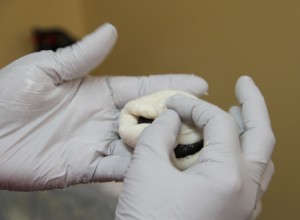
“Fried Oreos are popular,” said Eric. “I like just the frybread alone and the large Rez dog is my second favorite. We’re thinking about adding deep fried bananas as a dessert. I tried one of those and wow!”
“My favorite is probably just a piece of frybread with butter,” said Nadene. “But I also like the frybread burger.”
So, if you’re ready to fulfill your frybread fantasies, Doe’z Onda Go is the stop for you. Doe’z Onda Go is open Tusday through Saturday from 11:00 a.m. to 7:00 p.m. Short on time? Call in an order for quicker pick-up, 425-622-6289.
Click on the link below to download the July 9, 2014 Tulalip See-Yaht-Sub Issue
By Andrew Gobin, Tulalip News
“In 1996, Marysville and Tulalip had just built a bridge, the 88th Street Bridge,” began Tulalip Vice Chairman Les Parks as he delivered the annual Marysville Tulalip Chamber of Commerce State of Tulalip Address. He recalled the direction Tulalip was moving in when he first served on the tribal council, and how it has changed over the last 20 years, noting the focus and success of building an economy that is mutually beneficial for both Tulalip and Marysville.
“On the east side of this bridge was a brand new corridor–and it was a big day for the Marysville Tulalip area.” Today, it is a shopping plaza that includes Haggens, Starbucks and other retail stores. “But on the west side of the freeway there was nothing but a stand of cedar trees,” he recalled. “We went to work building Quil Ceda Village. One of the greatest feelings is to do what we did here at Tulalip, for our Indian people, and the dream and the vision that we had of economic success has become a reality.”
Since the construction of the 88th Street Bridge in 1996, the Quil Ceda Village business park experienced a rapid growth in economic development, creating a successful economy which continues to grow today. In that time, Quil Ceda Village also received a charter as a federal municipality, now operating as a city, governed by the Tulalip Tribes, and yet, separate from the tribal government. Because of that structure, Quil Ceda Village has been able to contribute immensely to the greater economic development and growth of Snohomish County. Since the establishment of first federal city, Washington D.C., Quil Ceda Village is the second federally chartered city in the nation. A dream realized after more than 50 years, the village is a thriving success which has the Tulalip Tribes poised to reclaim taxes.
“The Federal Register now contains language that prohibits states and counties from assessing taxes on building improvements on and off reservation when it’s Indian owned-land and affirmed by the Great Wolf Lodge case this September in the Ninth Circuit,” continued Vice Chairman Parks. “We are currently in the process of developing an Assessor’s office so that we can begin to assess those taxes we’ve always known were ours. Tulalip itself, and I know it has been told to the Marysville Tulalip Chamber of Commerce many times, put a ton of money into the infrastructure, in the ground we’re sitting on, to the tune of about $65 million. Now I believe we are in excess of $100 million.”
“And who gets to benefit from the tax?” he asked. “Marysville does, Snohomish County does, the state does, but Tulalip gets zero,” Vice Chairman Parks explained.
There are a number of Tulalip public works projects that are underway, planned, or in the planning process that will ease some of the stressors and impacts which accompany economic expansion. Most notably are the utilities project known as the Big Water project, and revisions to the 116th Street Freeway Overpass to streamline traffic flow. Currently, the overpass is a bottleneck, with one lane in each direction, and a center turn lane for each freeway onramp.
Parks announced, “Next month we’re going to put out to bid to start construction of the bridge. In eighteen months, we’re going to see a six-lane bridge, which is what everybody’s been waiting for,” he said. “Largely, Tulalip is the lead on that project; we invest a lot of money, a lot of time, a lot of effort. We know we have been responsible for the traffic nightmare, we know Marysville has been partially responsible, but we have taken the lead. We do that because we want to be good neighbors. We want our success to be your success, and your success to be ours. Thank you Marysville, thank you everybody that’s contributed to that project,” said Vice Chairman Parks.
“In about two years we’re going to have water pumping through that new water main. 36 million gallons a day, that’s a lot of water. We may not need all that water yet but future generations will. When we decided to invest in that line through a negotiated settlement with Mayor Ray Stephanson, and the City Council of Everett, we wanted water to enhance and augment our stream flows, where our salmon are being raised, and we wanted to do that due to the loss of habitat. We want water back at Tulalip, and we’re going to use water for our people, and we’re going to us water for our salmon. For me, particularly exciting is we’re going to be able to ground inject some of that water into our streams that have low flow during the summer months, and we are going to start seeing more salmon. More salmon for our people, because that’s who we are, salmon people. That water main is two years away and stream augmentation is right behind it.”
Vice Chairman Parks emphasized the importance of Tulalip youth and the fact that they are the next generation of Tulalip leaders. Much has been set aside for them but what has been done to prepare them to manage their success? Chairman Herman Williams, who spoke at the State of the Tribes Address following Vice Chairman Parks, said he and Tulalip Board of Directors have made it clear that education is an important focus of their administration.
On March 29 of this year, the Marysville School District held a summit on education and what role it should play in the success of students. There, Troy McClelland, president and CEO of the Economic Alliance of Snohomish County said, “Snohomish County is first in the state in manufacturing. We are second in the technology field. There are many successful economies in the state, but what makes us different is, in Snohomish County, we build things. There is a place for every student to succeed, if we continue to provide the competitive economy.” Chairman Williams noted that he has spoken with Marysville Superintendent Dr. Becky Berg about this very issue, saying that what students need most for our local economy are tools. They get an education, yet lack the tools and skills to succeed.
Parks said, “For the first time in the United States, a Indian TERO program is able to certify apprenticeships in the state in which we live. Chairman Williams has had a dream that we will have a full-fledged vocational training center on the reservation. And he’s talked about this for years, he’s talked about educating our youth, and he has walked his talk over the years. He knows how important it is to educate our youth, but he also knows that when they leave high school not all of them want to go to college. Some of them want to enter into the trades, some of them want to get trained in computers; and so he’s wanted this vocational training center. The TERO commission really has taken the first step in getting that done with the apprenticeship program. I know that in the very near future, Chairman Williams is going to continue to push, and we will soon have a full-fledged vocational training center on the reservation.”
Vice Chairman Parks ended the State of the Tribes address by thanking the Tulalip and Marysville communities for their coordinated efforts to support the victims and their families of the Oso Landslide, calling it one of the most tragic events in Washington’s history. “The Oso tragedy brought back to memory a piece of Tulalip history in 1830,” he said. “We lost many of our ancestors in a slide right off the tip of Camano Island. That slide buried many, and the subsequent Tsunami drowned many more that were subsisting in villages on the beaches of Hat Island. Our Oso brothers and sisters were welcomed by our Tulalip brothers and sisters at Heaven’s gates. Today I ask that we honor and remember those lost in both tragedies,” he said.

New Hibulb exhibit gives an in-depth look at Tulalip’s canoe culture
By Brandi N. Montreuil, Tulalip News
TULALIP- “Imagine you are at the shore of the Salish Sea where a grand ocean-going family canoe floats patiently, waiting for you and others to begin your journey. The rivers, lakes and seas are our earth’s arteries, carrying its life force of water. For thousands of years they functioned as our ancestors’ highways, connecting our people together,” reads the opening display panel in the new interactive temporary Hibulb Cultural Center and Natural History Preserve’s exhibit, “A Journey with our Ancestors: Coast Salish Canoes.”
The new exhibit, on display through June 2015, explores canoe culture in Tulalip and in Coast Salish tribes. A soft opening for the exhibit was held on Friday, June 27, with over 80 guests in attendance. This interactive exhibit features over 70 items that guests can explore canoe culture through, such as videos on carving canoes, maps, display panels, paddles and tools used to carve canoes with, and a large canoe that guests can sit in.
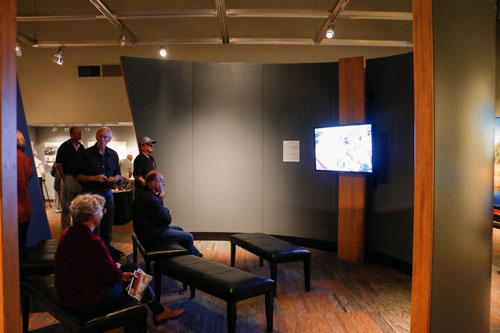
“We hope guests learn the importance of canoes and how they were tied to all aspects of our life,” explains Mary Jane Topash the center’s tour specialist, about what guests can expect from the new exhibit. “We hope to educate people on the types of canoes, anatomy, tools, what it takes to build one, and how they are still used to this day. This exhibit will encompass all aspects of the teachings, history, lifestyle, and how their importance hasn’t changed a whole lot over the years.”
Coast Salish Canoes highlights the roots of the Canoe Journey and the important role that canoes played in its revitalization during the 1989 Paddle to Seattle.
“It was a big learning process for us. It didn’t just happen in 1989,” explained Tulalip carver Joe Gobin, about the preparation involved in the Paddle to Seattle. “Frank Brown and Ray Fryberg Sr. got our [Tulalip] Board involved and the Board saw how this was something missing in our culture. They sent us to different reservations to learn, to Lummi and Makah, because none of us knew how to carve a canoe. We all talked about it and the tools we needed, and how when we were making the canoe we were bringing the tree back to life. And it did come back to life on the reservations, and it brought back so many things in our culture that were forgotten. I am glad to see this exhibit here.”

Lena Jones, the center’s curator of education, says guests will leave knowing the importance of canoes in Coast Salish culture. “Our ancestors helped keep a rich environment with superb art. We hope the exhibit will help people appreciate the social gatherings of the Coast Salish people and help our young people recognize their community’s role in revitalizing important Coast Salish traditions that can, and do, help the region.”
For more information on “Coast Salish Canoes,” please visit the Hibulb Cultural Center and Natural History Preserve’s website at www.hibulbculturalcenter.org.
Brandi N. Montreuil: 360-913-5402: bmontreuil@tulalipnews.com
CedarPulling6-27-14A from Brandi Montreuil on Vimeo.
Sisters continue tradition of cedar harvesting
By Brandi N. Montreuil, Tulalip News
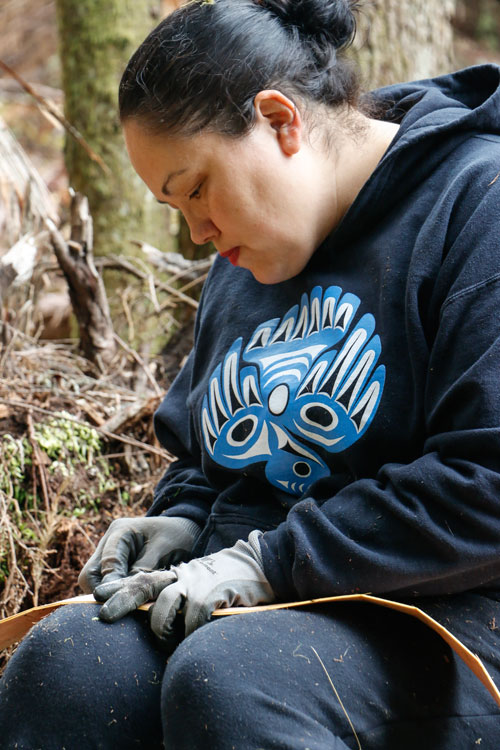
Leaning over a long strip of red cedar placed on her lap, Tulalip tribal member Cerissa “Pipud” Gobin, asked her 4-year-old daughter, Emmy “Pipud” Ramsey, if she knew what was in the center of the cedar tree.
“What is in the center of you? That is right; it is your heart. So in the center of the cedar tree is a heart,” said Gobin, as she continued her methodical rhythm of peeling inner bark from the outer bark on a strip of cedar that was recently cut from a nearby group of trees.
“When I first started pulling I had no idea what I was doing,” said Gobin. “I learned as I went along. I learned to get the little pieces of bark left on the inside off before you leave, otherwise you are going to spend a lot of time trying to get it off later,” she continued, occasionally looking up from the long strip on her lap to watch her son, Coen, pull another strip of bark off a tall red cedar.
Clustered around Gobin and her sister, Chelsea Craig, also a Tulalip tribal member, were long strips of cedar waiting to have their inner bark stripped, which will be used to make cultural items. Outer bark is left for the forest to reclaim. Both women are educators who plan to use the cedar for in-class projects next year.
Gobin, a high school art educator at Heritage High School, uses the cedar to teach students how to make traditional headbands or bracelets, some of which are later used during graduation ceremonies. Craig, a teacher at Quil Ceda & Tulalip Elementary, uses the cedar to teach youth to make baskets, hats, and pins for potlatch giveaways. Although they teach students how to weave different items, together they weave a cultural foundation for Tulalip youth.
These women are part of a large group of Tulalip tribal members participating in a cedar harvest organized by Tulalip Forestry

Department on June 27-28. The event, and others like it, is made possible by a growing partnership between the Tulalip Tribes and the Washington State Department of Natural Resources. The land is owned by DNR, with Sierra Pacific owning the timber. Department of Natural Resources notifies Tulalip Forestry when an area is scheduled to be cleared. This season, 83 acres were available for harvesting cedar.
“Tulalip Forestry worked in conjunction with both agencies’ representatives to coordinate the event and establish ground rules regarding allowable and non-allowable trees to be pulled,” explained Ross Fenton with the Tribe’s forestry department. “The relations Tulalip Forestry has established over the years for cultural cedar bark gathering has gone exceptionally well. Some tribal members base their sole incomes on products they make from cedar bark, so it’s very important we continue to maintain these positive relations.”
“Traditionally we would come out to harvest when the sap would run. That makes it easy to pull it off the tree. This stuff peels so nicely, I am loving it,” said Craig, pausing for a moment to survey the large expanse of trees swaying in the afternoon wind. “It is amazing to sit here and think about how our people used to do this. How they would all come together with their families and gather cedar. Of course they didn’t use the same tools we are using today, but they came out and gathered and made things, some of which we still have today.”
Many Tulalip youth participated in the two-day cedar-harvesting event, gathering strips for elders and learning techniques of separating the smooth inner bark from the rough outer bark. For many, this was their first trip gathering cedar.
“Do you know how the cedar is related to us?” asked Craig to her nephew and nieces, who were struggling to bring the long cedar strips up the steep incline. “She is our grandmother and she is giving us this gift of cedar and we need to thank her.”
“I love being out here,” said Gobin, as she tightly wound her cedar into a bundle tying it off with a scrap of thin cedar. “It is really addicting to be out here stripping the cedar, it is one of my favorite things to do.”
“Yes, grandpa would be proud of us,” remarked Craig.
For more information regarding future cedar harvesting events, please contact Tulalip Forestry at 360-716-4000.
Brandi N. Montreuil: 360-913-5402; bmontreuil@tulalipnews.com